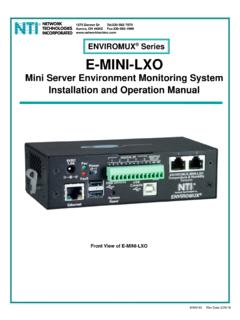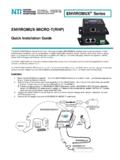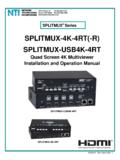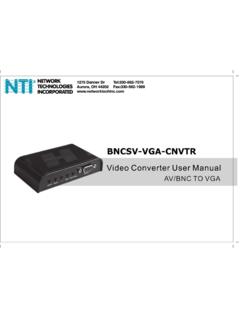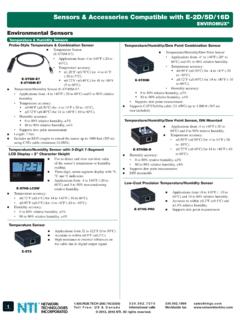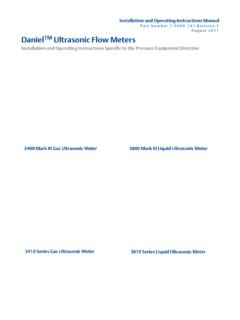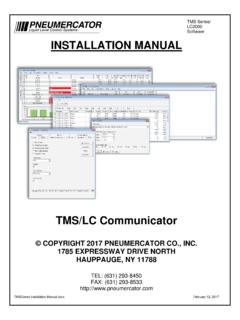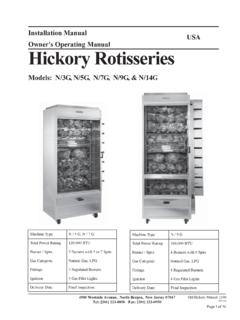Transcription of Sensor Installation Manual - Network Technologies …
1 ENVIROMUX Series Sensor Installation Manual E-T / TRHM-E7. Temperature/Humidity sensors E- LDSx-y Liquid Detection Sensor E-SRN-M. E-BCN-R Siren Beacon E-TDS. E-M-DCS Tamper Switch Door Contact Switch MAN057 Rev Date 4/17/2018. NTI ENVIROMUX Sensor Installation . TABLE OF CONTENTS. 2. Connect Sensors to E-MINI-LXO /-MICRO-T(rhp).. 2. E-T or 2. Sensor Cable .. 3. 4. Contact Sensors .. 5. Connect Sensors to The E-xD 6. RJ45 Sensors .. 6. Temperature, Humidity Sensors .. 6. Contact Sensors .. 7. Digital In 7. Liquid Detection 9. BEACON and SIREN Connections .. 10. RJ45 Sensor 11. Liquid Detection False Alert 11. TABLE OF FIGURES. Figure 1- Connect sensors to E-MINI-LXO .. 2. Figure 2- Liquid detection 4. Figure 3- Terminal block for dry-contact 5. Figure 4- Sensors connected by cables with RJ45 6. Figure 5- A portion of the Sensor configuration page.
2 6. Figure 8- Contact Sensor wired to RJ45 socket .. 7. Figure 9- DIGITAL IN terminal blocks on ENVIROMUX Systems .. 7. Figure 10- Basic DIGITAL IN Terminal Connections .. 8. Figure 11- Secure liquid detection Sensor with tape .. 9. Figure 12- Portion of Water Sensor configuration page .. 9. Figure 13- Connect visual and audible external 10. 1. NTI ENVIROMUX Sensor Installation . INTRODUCTION. Many different sensors can be connected to the ENVIROMUX Series Enterprise Environment Monitoring Systems. Series models include E-16D/5D/2D, E-MINI-LXO and E-MICRO-T(RHP). A complete listing of available sensors and accessories can be found at for the E-16D, for the E-5D, for the E-2D, and for the E-MINI-LXO. for the E-MICRO-T(RHP). Manuals for each Environment Monitoring System covering Installation and configuration for all features can also be found at these websites.
3 This Manual is only provided to instruct how to connect the various sensors to these systems. CONNECT SENSORS TO E-MINI-LXO /-MICRO-T(RHP). E-T or TRHM-E7. For measuring temperature and humidity, the E-MINI-LXO and E-MICRO-T(RHP) uses the E-T-E7 (temperature only), E-TRHM- E7 (combination temperature and humidity Sensor ). For high-temperature environments, E-MINI-IND uses the E-T-IND-E7 High Temperature Sensor . 1. Connect either of the temperature / humidity sensors to an available port on the E-MINI-LXO. Plug the RJ45 connector to either of the two ports marked "TEMPERATURE/HUMIDITY". The E-T/TRHM-E7 sensors can be secured anywhere that the temperature and/or relative humidity need to be sensed. Note: The E-TRHM-E7 Sensor will work with the E-MINI-LXO provided firmware version or later is installed, and with the E-MICRO provided firmware version or later is installed.
4 2. Power-cycle the E-MINI-LXO after the Sensor (s) have been plugged-in. Note: Mounting the Sensor in the path of a fan or on a heated surface may affect the accuracy of the Sensor 's readings. Note: For best results, use the E-T-IND-E7 with model E-MINI-IND. To extend a Sensor cable (up to 500 feet long) requires E- MINI-LXO firmware version or later. Figure 1- Connect sensors to E-MINI-LXO. 2. NTI ENVIROMUX Sensor Installation . TEMPERATURE AND HUMIDITY SENSORS FOR E-MINI-LXO AND E-MICRO-T(RHP). Sensor MODEL OPERATING TEMPERATURE HUMIDITY RANGE ACCURACY. RANGE. E-T-E7 32 to 104 F (0 to 40 C) n/a F ( C). E-TRHM-E7 -4 to 185 F (-20 to 85 C) 0 to 90% RH. F ( C) for -4 to 14 F (-20 to -10 C). F ( C) for 14 to 185 F (-10 to 85 C). 5% RH. E-T-IND-E7 32 to 167 F (0 and 75 C) n/a F ( C). Sensor Cable The CAT5 connection cable between the E-MINI-LXO / E-MICRO-T(RHP) and the RJ45 Sensors is terminated with RJ45.
5 Connectors and must be wired according to the EIA/TIA 568 B industry standard. Wiring is as per the table and drawing below. Pair 3. RJ45 Sensor Socket Wiring for E-MINI-LXO. and E-MICRO-T(RHP): Pair 2 Pair 1 Pair 4. Signal Pin Wire Color Pair +5 VDC 1 White/Orange 2. TRIG 2 Orange 2 T R T R T R T R. SCL 3 White/Green 3. GND 4 Blue 1. 1 2 3 4 5 6 7 8. + - + - + - + - SDA 5 White/Blue 1. GND 6 Green 3. FREQ 7 White/Brown 4. ID 8 Brown 4. (View Looking into RJ45 Socket). 3. NTI ENVIROMUX Sensor Installation . E-LD. Connect the liquid detection Sensor E-LD to a set of terminals (1-5) marked DIGITAL IN . The twisted orange sensing cable should be placed flat on the surface (usually the floor) where liquid detection is desired. If tape is required to hold the Sensor in place, be sure to only apply tape to the ends, exposing as much of the Sensor as possible.
6 At least 5/8" of the Sensor must be exposed for it to function. (See Figure 2). Do not expose connector to liquids. Do not submerge. Figure 2- Liquid detection Sensor Note: The connection between the two-wire cable and the Sensor cable is not designed for exposure to liquids and cannot be submerged. Liquid Detection Rope Maintenance For periodic maintenance, you can clean the rope with isopropyl alcohol without completely removing the rope from its installed location. 1. Remove the section that you want to clean from its self-adhesive clips. 2. Soak the alcohol in a dye-free rag and proceed to wipe it around the rope, squeezing firmly while pulling the rag down the length of the rope. 3. Flip the rag every several feet and re-saturate the rag with alcohol when needed. 4. After cleaning a section of the rope, you can replace it and continue to clean the next section in similar fashion.
7 5. Replace the rag if it becomes too dirty. If the rope is still giving you problems after you have cleaned it with isopropyl alcohol or if you think the rope needs a good scrubbing, you can clean it with warm soapy water. You will have to remove the rope from its installed location. It may be helpful to label the sections of the rope or note their locations before you start for an easier re- Installation . 1. Gather Dawn dish soap, a large bucket or plastic bin, warm water, soft-bristled scrub brushes, and clean rags. 2. Add dish soap to the bucket of water, approximately 1 cup of detergent to 1 gallon of warm water. To determine if the solution is concentrated enough, place your finger and thumb in the water and rub them together. You should feel a slick/slimy residue. If you do not feel a residue, add more detergent to the water and gently mix to distribute the soap.
8 3. Submerge a section of the rope in the water. Using a scrub brush or rag, scrub along all sides of the rope with firm pressure. 4. Remove the section of the rope from the soapy solution and rinse it in a bucket of clean, fresh water. 5. Ensure that there are no oily deposits along the length of the rope. If the rope does not appear clean, submerge it in water and scrub again, repeating steps (3) to (5). 6. Hang the clean rope up to dry. Try to point the connectors down, so water cannot pool inside the connectors. The drying process may take 6-8 hours, depending on the room conditions. 7. When the rope is completely dry, reinstall it in its original location. 4. NTI ENVIROMUX Sensor Installation . Contact Sensors Up to five dry-contact sensors or liquid detection sensors can be connected to the terminals marked DIGITAL IN.
9 Sensors with 16-26 AWG connection wires that operate on 5V at 10mA maximum current may be used. A contact resistance of 10k or less will be interpreted by the E-MINI-LXO as a closed contact. Examples of Dry-Contact Sensors for the E-MINI-LXO: NTI # Description NTI # Description E-EBS Emergency Button E-SDS-PA Smoke Detection Sensor -Power added E-IMD-P Infrared Motion Sensor w/power E-TDS Tamper Switch E-M-DCS Door Contact Sensor To install the dry-contact Sensor (s): A. Attach the positive lead to a terminal corresponding to a "+" marking on the E-MINI-LXO and the ground lead to the next terminal to the right that will correspond to a marking on the E-MINI-LXO. Tighten the set screw above each contact. Terminal sets are numbered 1-5. B. Mount the sensors as desired. Figure 3- Terminal block for dry-contact sensors Note: The terminal block is removable for easy Sensor wire attachment if needed.
10 Shielded cable must be used to connect to the DIGITAL IN terminals in order to meet CE emission requirements. Connect the drain wire of the shield to the ground ( ) terminal of the dry contact in addition to the contact return wire. 5. NTI ENVIROMUX Sensor Installation . CONNECT SENSORS TO THE E-XD MODELS. RJ45 Sensors Several sensors for the E-16D/5D/2D Enterprise Environment Monitoring Systems have RJ45 connection ports. Some of these sensors include E-STS (temperature only), E-STHSB (temperature and humidity), E-STHS-99 (wide range temperature and humidity) and E-LDS (liquid detection). In all cases, the CAT5 cable between the Sensor and the ENVIROMUX can be up to 1000. feet in length. Temperature, Humidity Sensors Note: It is very important to locate the temperature and/or humidity sensors away from ventilation sources and fans.

